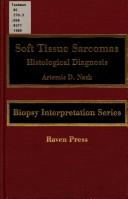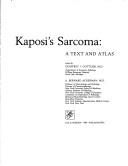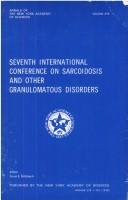| Listing 1 - 10 of 10 |
Sort by
|
Book
Year: 1890 Publisher: Liège : Imprimerie H. Vaillant-Carmanne,
Abstract | Keywords | Export | Availability | Bookmark
Dissertation
Year: 1933 Publisher: Paris : Le François,
Abstract | Keywords | Export | Availability | Bookmark
 Loading...
Loading...Choose an application
- Reference Manager
- EndNote
- RefWorks (Direct export to RefWorks)
Sarcome d'Ewing. --- Sarcome d'Ewing. --- Sarcome d'Ewing --- Thèses et écrits académiques.

ISBN: 0890047081 9780890047088 Year: 1989 Publisher: New York : Raven Press,
Abstract | Keywords | Export | Availability | Bookmark
 Loading...
Loading...Choose an application
- Reference Manager
- EndNote
- RefWorks (Direct export to RefWorks)
Sarcoma --- Sarcoma --- Sarcoma --- Diagnosis, Electron microscopic --- Sarcome --- Sarcome --- Sarcome --- Diagnostics par microscopie électronique --- Histopathology. --- Diagnosis --- Cytodiagnosis. --- Histopathologie --- Diagnostic --- Cytodiagnostic
Book
Year: 1874 Publisher: Paris : Adrien Delahaye, libraire-éditeur,
Abstract | Keywords | Export | Availability | Bookmark
 Loading...
Loading...Choose an application
- Reference Manager
- EndNote
- RefWorks (Direct export to RefWorks)
Sarcoma. --- Melanoma. --- Ophthalmology. --- Sarcome. --- Mélanose. --- Ophtalmologie.
Dissertation
Year: 1934 Publisher: Paris : Le Francois,
Abstract | Keywords | Export | Availability | Bookmark
 Loading...
Loading...Choose an application
- Reference Manager
- EndNote
- RefWorks (Direct export to RefWorks)
Birds. --- Sarcoma. --- Birds. --- Sarcoma. --- Animal Population Groups. --- Neoplasms. --- Oiseaux. --- Sarcome. --- Birds. --- Sarcoma.

ISBN: 0812110412 Year: 1988 Publisher: Philadelphia Lea & Febiger
Abstract | Keywords | Export | Availability | Bookmark
 Loading...
Loading...Choose an application
- Reference Manager
- EndNote
- RefWorks (Direct export to RefWorks)
Kaposi, Sarcome de --- Sida. --- Atlas --- AIDS (Disease). --- Kaposi's sarcoma --- Kaposi's sarcoma. --- Sarcoma, Kaposi's --- Sarcoma, Kaposi's. --- Atlases. --- atlases. --- AIDS (Disease) --- Addresses, essays, lectures --- Atlases
Dissertation
Year: 2001
Abstract | Keywords | Export | Availability | Bookmark
 Loading...
Loading...Choose an application
- Reference Manager
- EndNote
- RefWorks (Direct export to RefWorks)
Human diseases --- Human diseases --- Carcinogenesis --- Carcinogenesis --- proteins --- proteins --- Enzyme activity --- Enzyme activity --- Arabidopsis thaliana --- Arabidopsis thaliana --- Saccharomyces cerevisiae --- Saccharomyces cerevisiae --- gene expression --- gene expression --- Models --- Models --- Structure moleculaire --- Sarcome d'ewing --- Gtpase activating proteins --- Structure moleculaire --- Sarcome d'ewing --- Gtpase activating proteins
Periodical
Abstract | Keywords | Export | Availability | Bookmark
 Loading...
Loading...Choose an application
- Reference Manager
- EndNote
- RefWorks (Direct export to RefWorks)
Oncology. Neoplasms --- kwaadaardige gezwellen --- Sarcoma --- Sarcome --- Periodicals. --- Périodiques --- Sarcoma. --- Health Sciences --- Life Sciences --- Clinical Medicine --- General and Others --- Micro and Molecular Biology --- oncology --- sarcoma --- Oncology. --- Connective Tissue. --- Cancer --- Tumors --- Sarcoma, Epithelioid --- Sarcoma, Soft Tissue --- Sarcoma, Spindle Cell --- Epithelioid Sarcoma --- Epithelioid Sarcomas --- Sarcomas --- Sarcomas, Epithelioid --- Sarcomas, Soft Tissue --- Sarcomas, Spindle Cell --- Soft Tissue Sarcoma --- Soft Tissue Sarcomas --- Spindle Cell Sarcoma --- Spindle Cell Sarcomas
Dissertation
Year: 2020 Publisher: Liège Université de Liège (ULiège)
Abstract | Keywords | Export | Availability | Bookmark
 Loading...
Loading...Choose an application
- Reference Manager
- EndNote
- RefWorks (Direct export to RefWorks)
Ewing sarcoma is an aggressive cancer of the bone and soft tissues that affects mostly adolescents and young adults. Metastatic and relapsed Ewing tumors are still associated with a dismal prognosis, which emphasizes the need for new therapeutic perspectives. Ewing tumor cells are characterized by a chromosomal translocation that leads to the formation of a novel fusion oncogene called EWS-FLI1. The resulting oncoprotein acts as an aberrant transcription factor and completely rewires the gene expression programs of the cell through both transcriptional and post-transcriptional mechanisms. Recently, a role in mRNA decay was highlighted that is thought to occur via the recruitment by the oncoprotein of the CCR4-NOT deadenylase complex at the 3’ end of target mRNAs. The interaction between the transactivation domain of EWS-FLI1, called the EAD, and CNOT2, part of the CCR4-NOT complex, seems to be the basis of this new role in gene regulation. Therefore, disruption of this specific protein-protein interaction could be of high clinical relevance. Here, I aim to describe a detailed framework of how such disruption could be achieved by applying two distinct but complementary methods: high-throughput and virtual screening. High-throughput screening is a large-scale process that requires the use of robot-automated equipment to screen large chemical libraries of compounds for a desired biological activity. In this context, a comprehensive experimental protocol will be developed and optimized on the basis of luciferase-fragment protein complementation in a stable cell line expressing both protein partners. Quality control assessments will then be necessary to probe the robustness of our assay controls. Later, the primary screen is to be conducted following the careful selection of focused chemical libraries. Finally, secondary or counter-screens that aim to validate true active compounds will be performed. Virtual screening broadly describes the process of computationally docking large libraries of ligands onto a protein structure. Compounds that bind with high affinity are then selected for further experimental validations. Prior to large-scale screening however, it is important to map the EAD/CNOT2 interaction as precisely as possible to identify docking-relevant conformations. To that aim, two approaches were considered: in silico molecular dynamics simulations and in vitro mutagenesis experiments. The combination of the two methods has led to a precise characterization of the binding interface. In both high-throughput and virtual screening, biological validation and structure-activity relationship studies must be performed with the top-performing molecules identified. While currently ambitious in its scope, the framework presented in this master thesis provides relevant guidelines that would hopefully lead to the discovery of highly efficient and specific inhibitory small molecules for Ewing sarcoma. Le sarcome d’Ewing est un cancer agressif des os et des tissus mous qui affecte principalement les adolescents et les jeunes adultes. Les tumeurs d’Ewing métastatiques ou récurrentes sont associées à un faible taux de survie, ce qui souligne l’importance de la recherche de nouvelles pistes thérapeutiques. Les cellules tumorales de sarcome d’Ewing sont caractérisées par une translocation chromosomique qui entraîne la formation d’un nouvel oncogène appelé EWS-FLI1. L’oncoprotéine résultante se comporte comme un facteur de transcription aberrant qui reprogramme l’expression génique des cellules, en agissant tant au niveau transcriptionnel que post-transcriptionnel. Récemment, un rôle dans la dégradation de l’ARNm a été mis en avant. Cette nouvelle fonction serait basée sur le recrutement par l’oncoprotéine du complexe de déadénylation CCR4-NOT à l’extrémité 3’ des ARNm cibles, dont le fondement serait l’interaction entre le domaine de trans-activation de EWS-FLI1, appelé l’EAD, et CNOT2, membre du complexe CCR4-NOT. Par conséquent, la perturbation de cette intéraction protéine-protéine pourrait être de haute pertinence clinique. L’objectif principal de ce travail consiste à décrire un cadre qui permettrait une telle inhibition via deux méthodes distinctes mais complémentaires: le criblage haut-débit et virtuel. Le criblage haut-débit est un procédé à grande échelle qui requiert l’utilisation d’équipements robotisés afin de cribler des bibliothèques de composés chimiques (chimiothèques) contre une activité biologique spécifique. Selon ce cadre, un protocole complet sera développé et optimisé sur base d’une méthode de complémentation de fragments de luciférase dans une lignée cellulaire stable exprimant les deux protéines (EAD et CNOT2). Des évaluations de contrôle qualité seront ensuite nécessaires afin de mesurer la robustesse de nos contrôles. Par après, le crible primaire sera réalisé selon la sélection de chimiothèques pertinente. Enfin, un crible secondaire et un contre-crible auront pour but de valider les composés actifs. Le criblage virtuel est un processus informatique qui permet l’amarrage moléculaire de grandes chimiothèques sur la structure tridimensionnelle d’une protéine. Les composés qui se lient avec haute affinité sont ensuite sélectionnés pour des validations expérimentales. Avant cela cependant, il est important de caractériser l’interaction EAD/CNOT2 aussi précisément que possible afin d’identifier des potentiels sites de liaisons des ligands. Dans ce but, deux approches ont été considérées: des simulations de dynamiques moléculaires in silico, et des expériences de mutagénèse in vitro. La combinaison des deux méthodes a permis une analyse précise de l’interface de liaison entre les deux protéines. Dans le cas des deux méthodes décrites, la pertinence biologique et pharmacologique des composés les plus prometteurs devra être évaluée expérimentalement. Bien qu’ambitieux de par sa portée, le cadre présenté dans ce mémoire fournit des lignes directrices importantes qui pourraient amener à la découverte de nouvelles molécules inhibitrices dans le traitement du sarcome d’Ewing.
Ewing sarcoma --- EWS-FLI1 --- EAD --- mRNA decay --- CNOT2 --- CCR4-NOT --- high-throughput screening --- virtual screening --- protein-protein interaction --- small molecule inhibitor --- drug discovery --- Sarcome d'Ewing --- EWS-FLI1 --- EAD --- dégradation de l'ARNm --- CNOT2 --- CCR4-NOT --- criblage haut-débit --- criblage virtuel --- intéraction protéine-protéine --- découverte de médicament --- inhibiteur moléculaire --- Sciences du vivant > Biochimie, biophysique & biologie moléculaire

ISBN: 0890720576 9780890720578 Year: 1976 Volume: 278 Publisher: New York, N.Y. New York Academy of Sciences
Abstract | Keywords | Export | Availability | Bookmark
 Loading...
Loading...Choose an application
- Reference Manager
- EndNote
- RefWorks (Direct export to RefWorks)
Granuloma --- Sarcoidosis --- 616-006.44 --- 616-006.44 Tumours of lymphoid and reticular tissue. Lymphomata. Adenia. Granulomata. Myelomata. Chloromata etc. --- Tumours of lymphoid and reticular tissue. Lymphomata. Adenia. Granulomata. Myelomata. Chloromata etc. --- Besnier-Boeck disease --- Boeck's sarcoid --- Granuloma benignum --- Lymphogranulomatosis benigna --- Schaumann's disease --- Lymphoproliferative disorders --- Pseudotuberculosis --- Tumors --- Inflammation --- Congresses --- Immunological aspects&delete& --- Immunological aspects --- Immunology. Immunopathology --- Pathology of the respiratory system --- Crohn's disease --- Congresses. --- Sarcoidosis - Congresses --- Sarcoidosis - Immunological aspects - Congresses --- Granuloma - Congresses --- Granulome --- Sarcoidose --- Sarcome --- Tumeurs
| Listing 1 - 10 of 10 |
Sort by
|

 Search
Search Feedback
Feedback About UniCat
About UniCat  Help
Help News
News